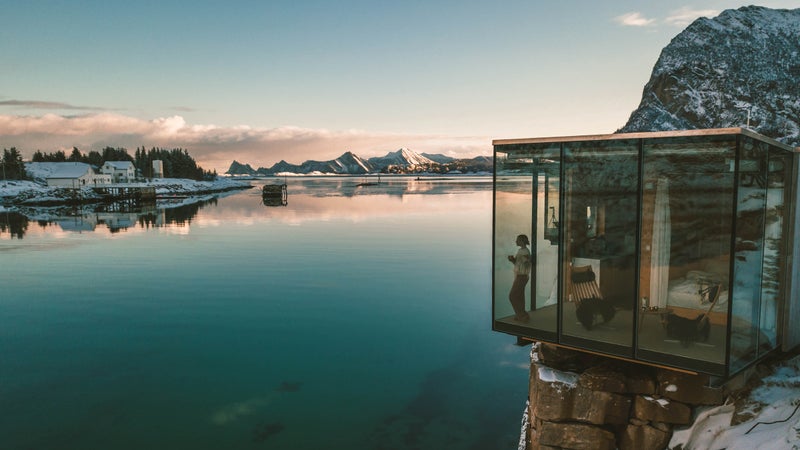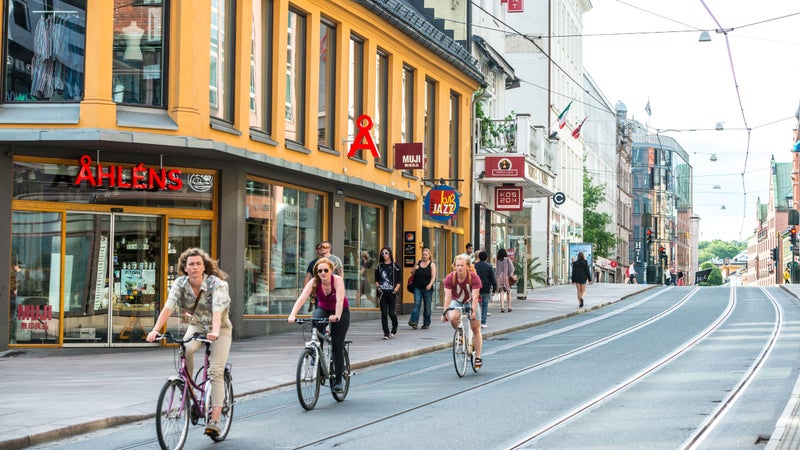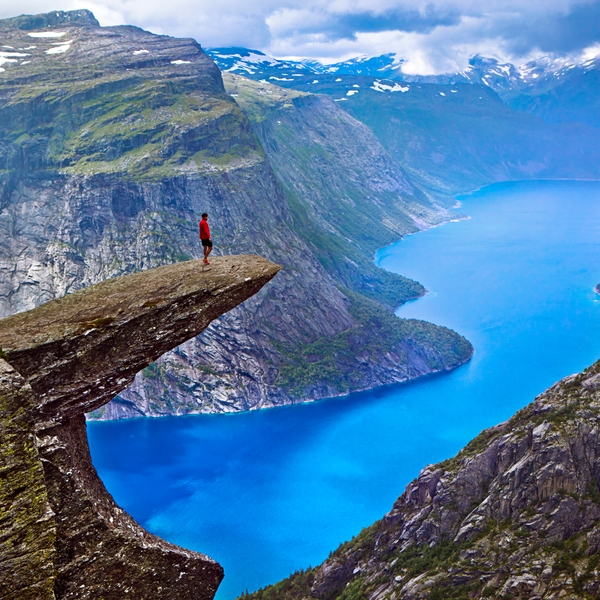Norway’s Bold Plan to Tackle Overtourism
And climate change at the same time
New perk: Easily find new routes and hidden gems, upcoming running events, and more near you. Your weekly Local Running Newsletter has everything you need to lace up! .
Above the Arctic Circle, in the middle of the Grotoya Strait, Borge Ousland is engineering a challenging dream. As the first person to cross Antarctica solo, the explorer knows hardship. In 2010, he bought a 55-acre island that has been a hub for fishermen since the 1600s, fully renovated its only salvageable 1800s-era house into a modern lodge, then built seven sustainable glass-sided cabins, from which guests can kayak, snorkel, fish, hike, and commune with the austere landscape. His ultimate goal: to make as close to 100 percent climate neutral as he can.
It’s a tough ask in the harsh northern environment. “I did investigate to see if it was possible to use the sun, but since it moves much lower and longer across the sky, there is very little sun in the winter,” says Ousland.
In lieu of that, the 57-year-old is constructing a windmill that will deliver power through a transformer back to the grid. Ousland and his small staff also sustainably harvest cod and halibut; hunt for moose, elk, and deer in season; raise sheep; grow potatoes, carrots, berries, and herbs; and buy local meat and cheese produced in the surrounding region.
“There really is no doubt about it, we must act now,” says Ousland. “Even if we went into climate neutral today, there is still so much CO2 in the atmosphere that it will affect the climate for decades, and the longer we wait, the worse and more expensive the consequences.” Aware that his full schedule of visitors create a carbon footprint, he adds, “It’s no use stopping the world and hiding in a cave. I hope Manshausen can be an inspiration for others who want to focus on solutions for less greenhouse-gas emissions and locally grown and harvested resources.”
Ousland’s actions exemplify those of his nation. In 2016, Norway announced its to become carbon neutral by 2030—two decades earlier than originally projected. In doing so, it must drastically reduce its CO2 emissions, about 53 million tons annually, by overhauling almost every system in the country, from transportation infrastructure to tourism, the latter of which is 4.2 percent of its GDP.
It’s one thing for a country of 5.5 million people to internally move toward climate neutrality, but how does Norway control the impact of a wave of incoming tourists? In 2017, the country received 6.3 million overnight visitors, a number expected to grow exponentially as global tourism increases. Overtourism has become a growing concern for communities across the globe. According to the UN World Tourism Organization, as of January 2019, international tourist arrivals worldwide reached 1.4 billion, two years ahead of forecasts. In Barcelona, Spain, 20 million tourists descend annually on a city with a population of 1.2 million. The locals have resorted to erecting anti-tourism billboards, protesting, and passing city ordinances limiting the number of vacation rentals. In the U.S., the overlook to Horseshoe Bend, a once lonely outpost along the Colorado River outside Grand Canyon National Park, has seen visitation skyrocket from a few thousand annual visitors to nearly two million in 2018. In Norway, Trolltunga, the famous promontory at the end of a grueling, 15-mile hike that soars thousands of feet above Lake Ringedalsvatnet, had 90,000 visitors in 2018, up from just 1,000 a decade ago.

“The challenge was: Where do I go for a piss? Where do I leave my garbage?” says Haaken Michael Christensen, an ecologist and the senior adviser to adventure tourism with , the government’s think tank for ingenuity and development. “The trails didn’t have the infrastructure to handle that.”
Surging visitor numbers are threatening Norway’s reigning principle of —the freedom to roam, a concept popular across all of Scandinavia. The thousand-year-old government policy states that individuals, as long as they are polite, can legally walk through any piece of undeveloped property and camp for one night without first obtaining the owner’s permission. This right has worked well for centuries, but in recent years, communities across the country are increasingly suffering from littering, human waste, and overzealous Instagrammers.
“It is a major issue for Norwegian politicians, tourism, and Norwegian NGOs to keep the right-to-roam policy intact,” says Ingunn Sornes, the special adviser to sustainable tourism for Innovation Norway. “This will demand a well-planned and well-informed integrated approach to local tourism management.”
To protect its beloved allemannsretten, the Norwegian government is spending nearly $37 million this year in investments and innovation related to sustainable tourism. For 2019, the Norwegian Environmental Agency has a budget of $1.2 million to award grants to local areas to fortify existing trails or build new ones to accommodate increased visitor numbers.
“The biggest challenge for us are 10 to 15 trails that exploded on social media,” says Christensen. “What we saw is when the volume of people rose quickly, trails were expanded in width, so two or three parallel trails were running alongside each other, and we had erosion.”
Pulpit Rock, a wildly popular hike that ends at a steep cliff rising 3,000 feet above a stunning fjord, received 300,000 visitors last year. Grant money was used to build a wider trail, expand the parking lot, and improve the garbage infrastructure. “As nature-based tourism is growing rapidly,” says Christensen, “we have to focus on managing nature and people the right way.”
The effort dates back to 2007, when the country began working on a sustainable-tourism plan. In 2013, it became the first country in the world to implement a sustainable destination national standard, which is now the model used by the , the international accreditation body for sustainable tourism.
“Norway has always been a sustainability trailblazer,” says Neil Rogers, a Stockholm-based consultant who has worked the past 40 years in eco-, adventure, and sustainable tourism. “Most Norwegians still live close to nature. They appreciate and care about the places they recreate in and understand that they must rapidly take actions to protect and conserve their environment and culture.”
The goes way beyond leaving a note in a hotel room asking guests not to change their towels. It covers six main sustainability themes, 45 criteria, and 108 indicators in the areas of nature, culture, environment, social values, community involvement, and economic viability. Once a destination devises a viable plan, it implements energy-saving initiatives and projects that promote local food and culture, and it builds infrastructure, like signposts and trails or trail upgrades. Those upgrades are then monitored before receiving accreditation. From start to finish, the entire process takes two to three years. “The long-term goal,” says Sornes, “is that every destination in Norway is making use of the system.”
“As nature-based tourism is growing rapidly,” says Innovation Norway’s Haaken Michael Christensen, “we have to focus on managing nature and people the right way.”
As of early 2019, there were 13 accredited sustainable destinations, with 23 more in the pipeline. The most interesting is the Svalbard Archipelago, above the Arctic Circle, halfway between Norway and the North Pole. Its capital, Longyearbyen (population 2,100), is the northernmost as well as the fastest-warming city on the planet. It exists because American industrialist John Munroe Longyear built a coal mine there in 1906. (All coal mines except one have since closed.) Longyearbyen is also home to the Global Seed Vault, the backup for the world’s 1,750 regional seed banks. Temperatures have been nine degrees above average here for the past six years straight, but still, 140,000 tourists per year, most of whom arrive on cruise ships, flock to the island group to see glaciers, polar bears, and the aurora borealis flicker across the sky.
“Tourism is the cornerstone of Longyearbyen, the only activity bringing resources to Svalbard not funded by the government,” says Ronny Brunvoll, a tourism adviser at Mimir, Norway’s longest-standing sustainable-tourism consulting agency, which played a vital role in creating Svalbard’s tourism plan. “Earning a sustainable grade through the accreditation process isn’t about being sustainable. It’s that you’ve taken responsibility as a destination to address sustainability issues, everything from social well-being to nature and climate to the economic well-being of businesses.”
Svalbard has taken a number of measures to manage its tourism, including banning cruise ships carrying heavy oil from national-park perimeters, avoiding worldwide marketing, developing wilderness experiences closer to Longyearbyen to reduce carbon-emitting snowmobile tours, and working on ways to extend the average visitor stay to increase per-capita spending and decrease transportation carbon emissions to the islands. It’s also toying with ideas like using footage from high-flying drones combined with 3-D technology to export the spectacular sights of Svalbard to people all over the world. “Do we have to bring the people to the polar bears, or can we bring the polar bears back to the people?” says Brunvoll.
To outsiders, Norway is one of those rare beautiful nations, like New Zealand or Switzerland, where almost everywhere you look there’s a stunning lake, fjord, or mountain, and almost every resident seems to be superhuman and spends an exorbitant amount of time outside. Norwegian society is set up to support this way of life, with the natural world woven into education from a child’s first day of school to public transportation that provides access to the outdoors. There’s a word for this: it’s called friluftsliv, which translated means open-air living, something Norwegians, like most Scandinavians, have practiced from birth.
“Sustainability is a notion that is very important for Norwegian society,” says Gaute Hagerup, the leader for smart cities and mobility at Innovation Norway. “It’s a part of the DNA of the way our society is built.”
In 2019, Norway’s Ministry of Climate and Environment budget is $1.6 billion, with even more funds allocated to environmentally relevant projects in sectors such as agriculture and transportation. Another $63.5 million from Innovation Norway is dedicated to miljoteknologiordningen—investments in environmental technology. Examples of these innovations are everywhere.
In Oslo, for instance, the city center is almost entirely car-free, with vastly expanded pedestrian and biking lanes; 56 percent of all public transportation is powered by renewable energy, including biogas produced from biowaste and city sewage; usage of the public-transport system has increased by 50 percent since 2007; and Oslo’s rivers and waterways are being restored, making them better wildlife habitats, conduits of stormwater, and more accessible to the public. In 2019, Oslo was crowned a by the European Commission. When I first visited Oslo more than 20 years ago, it immensely pleased me at how easily I could recreate from the city even then. From my downtown hotel, I took a tram 1,500 feet up to the Frognerseteren stop at the end of the line, hopped off, and hiked all day in Nordmarka, a hilltop forest that felt miles removed from a major city.
Oslo also has a climate budget, with 36 measures designed to tackle CO2 emissions from waste, buildings, and transport sectors. Meanwhile, directors of city agencies in Oslo have to report annual CO2 emissions.
“The United Nations has been so fascinated [by Norway’s climate budget] that they are visiting Oslo and trying to make it a global practice,” says Hagerup.
The efforts don’t stop there. As of March, 58 percent of new car sales in Norway were electric vehicles, and by 2025, all new car sales are projected to be zero emission. Last summer the $17 million, 400-passenger Future of the Fjords, Norway’s first all-electric vessel, started ferrying tourists across Næroyfjord, a Unesco World Heritage site. By 2025, Avinor, the company that owns the country’s airports, aims to have produced a hybrid aircraft that can travel more than 600 miles. By 2040, its goal is that all domestic flights will be electric. And Norway is spending almost $1 billion to build ten two-lane bike paths in and around its largest cities, allowing for safer, more seamless bike commuting.
“Brave decisions by politicians are driving this,” says Hagerup. “What they’ve said is that we need to not only have long-term visionary goals, we need to break it down into measurable units that we can act upon.”

Despite its push toward sustainability, Norway still has work to do. The wealthy, independent nation (it’s not a part of the European Union) is ranked fifth behind Sweden, Denmark, Switzerland, and Finland, out of 65 countries reviewed in the November 2018 from RobecoSAM, a group of investment specialists who focus on sustainable investing. (The U.S. is ranked 14th.) Meanwhile, Climate Action Tracker, an independent watchdog website, gave Norway an overall grade of insufficient in December 2018, because the country isn’t consistent in holding end-of-century warming below two degrees Celsius (3.6 degrees Fahrenheit) or the Paris Agreement’s stronger limit of 1.5 degrees (2.7 degrees Fahrenheit).
“The reason they look so bad, in our estimation,” says Andrzej Ancygier, a climate-policy expert with the Berlin-based Climate Analytics, one of the three research organizations that publishes the , “is that they are expected to do much more.”
Ancygier gives Norway credit for fast-tracking its carbon-neutrality efforts, but the elephant in the room, he says, is oil. Norway provides 2 percent of the global oil demand, its offshore wells producing 1.7 million barrels per day, which accounts for roughly half the country’s exports and feeds the $1 trillion Government Pension Fund of Norway, which amassed its wealth through investing surplus revenues of the country’s petroleum. In 2017, Peter Erickson, a senior scientist with the Stockholm Environment Institute, found that Norway’s oil exports will ultimately emit as the country’s domestic emissions.
In March, the Norwegian government announced it will gradually divest its shares in companies engaged in the exploration and extraction of oil and gas. (But it will still invest in companies that refine and sell oil.) And in April, parliament withdrew support for drilling off the Lofoten Islands, where there is an estimated one to three billion barrels of oil buried in the seabed. Keeping this Arctic region off-limits to oil exploration will drastically reduce Norway’s ability to maintain production levels.
In 2018, Norway ranked fifth among developed nations—behind Iceland, Switzerland, Germany, and New Zealand—in the , published by the ���ϳԹ��� Travel Trade Association (ATTA). The ranking takes into account ten pillars of responsible travel, including sustainable development policy.
“Over the past decade, Norway moved from predominantly trying to attract travelers to taking a more proactive stance toward development that is truly more sustainable,” says Christopher Doyle, executive director for Europe and Central Asia for the ATTA. “Norwegians, as in most Nordic countries, are incredibly resourceful. New concepts seem to emerge monthly that really turn heads. They’re hungry to partner, to learn, and to pilot concepts and initiatives. There’s truly a no-fear climate, and that has resulted in some rather amazing developments. But the impact of cruise tourism has been one of their toughest challenges.”
As of March, 58 percent of new car sales in Norway were electric vehicles, and by 2025, all new car sales are projected to be zero emission.
According to the Norwegian Centre for Transport Research, the number of cruise-ship tourists to Norway has increased from 100,000 to nearly 800,000 over the past 25 years, with an estimated 1.6 million passengers expected to arrive by 2060. Norway is taking steps to mitigate this impact. The Norwegian cruise line Hurtigruten, in conjunction with Rolls-Royce, is developing a new ship to be delivered later this year that will reduce fuel consumption by 20 percent using an auxiliary electric engine. A second ship, built with a full hybrid engine that can travel greater distances, will be ready in 2020. The $14.2 million investment in new technology is being shared by Hurtigruten and Enova, a Norwegian government enterprise.
Hurtigruten is also partnering with local communities. “The first trip we had, in 2007, was a really bad feeling, like I was selling myself,” says Ellinor Guttorm Utsi, a Sami reindeer herder who, with her husband, started , a tourism business on the Nordkyn Peninsula, the northernmost tip of mainland Norway. Their two-and-a-half-hour Taste of Lapland tour introduces Hurtigruten guests to their traditional way of life. In addition to touring 5,000 annual cruise-ship visitors, the family makes Sami handicrafts and has limited lodging accommodations for more independent travelers. After 12 years in business, Utsi’s perspective has changed.
“Today we see that people think it’s so important to meet Sami people, so we can tell them our true story,” she says. “I am a voice to talk about how to protect the future of reindeer herding. We need to show that this is a living culture, not just the culture you read about in a book.”
Other Norwegian outfitters are sustainably focused, too. Didrick Ose and his business partner, Petter Thorsen, who were both in the Norwegian navy’s special forces before starting their company , lessen their carbon footprint by focusing on human-powered cycling, trekking, and kayaking tours. Rather than loading their guests up in a van, they use electric vehicles for hire or public transportation. One particularly cool adventure the duo offers is e-biking Trollstigen, the famous serpentine mountain road lined by precipitous cliffs and rushing waterfalls in the spring, when roads are closed to cars. Cyclists strap skis on their bikes in order to then skin up and ski down the empty surrounding peaks.
“Norway is a social democratic country, and we want to share our wealth and knowledge for a better world,” says Ose. “If we can make money on doing so, it is just an example of sustainability working.”
Then there’s , the world’s first energy-positive hotel, being built on the Helgeland coastline above the Arctic Circle. Located at the base of the Svartisen Glacier, the futuristic orb—it’s round so that every room has a view—looks like a spaceship rising on stilts out of the crystalline waters of the Arctic fjord. The hotel will harvest enough solar energy to cover construction and operations and will ultimately use 85 percent less energy than comparably sized hotels. The hotel’s owners are currently creating an environmental-responsibility policy that will include a plan to offset guests’ travel carbon emissions. Scheduled to open in late 2021, the hotel will start accepting bookings in early 2020.
As for Borge Ousland, he’s working as fast as he can toward sustainability. “I strongly believe there is not much time,” he says. “Norway could and should do so much more. I want to be able to look into my grandchildren’s eyes and say that at least I took a stand and did something. As one Norwegian environmentalist told me: ‘It’s too late to be a pessimist.’”


